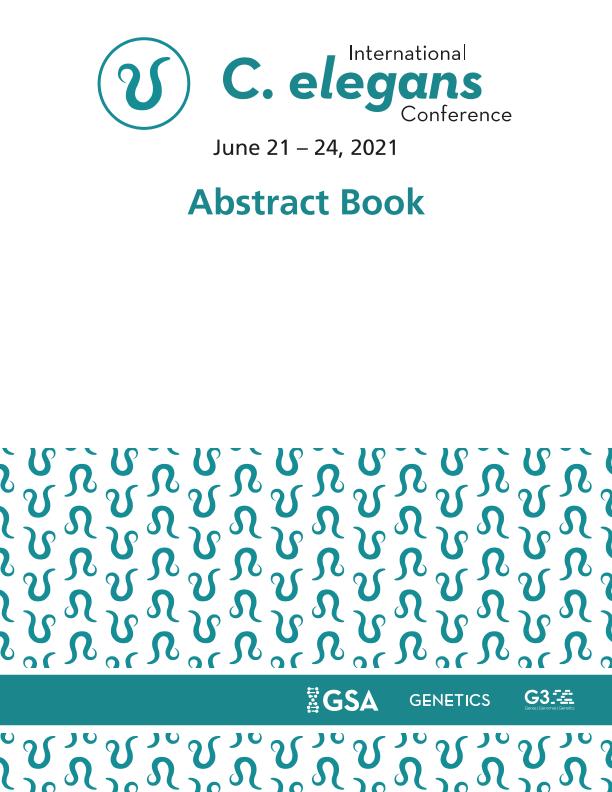Mostrar el registro sencillo del ítem
dc.contributor.author
Hernando, Guillermina Silvana

dc.contributor.author
Turani, Ornella

dc.contributor.author
Bouzat, Cecilia Beatriz

dc.contributor.other
Andrews, Brenda J. A.
dc.contributor.other
Lipshitz, Howard
dc.date.available
2022-07-14T13:25:42Z
dc.date.issued
2021
dc.identifier.citation
Deciphering the molecular mechanisms underlying the anthelmintic effect of essential oils evaluated in Caenorhabditis elegans; 23rd International C. elegans Conference; Estados Unidos; 2021; 501-501
dc.identifier.uri
http://hdl.handle.net/11336/162111
dc.description.abstract
Helminths consist of a diverse group of parasitic worms including nematodes, which cause diseases of major socio-economic importance globally. Control of infections in both human and veterinary medicine currently relies mainly on chemotherapy, but acquisition of resistance is an increasing problem, so there is an urgent need for discovery of novel drugs. As parasitic nematodes are not ideal laboratory animals, C. elegans has demonstrated to be a model system for the discovery of new anthelmintics and for characterizing their mechanisms of action and resistance. Essential oils (EOs) are natural products produced by aromatic plants. We here perform paralysis assays of wild-type and mutant C. elegans strain to identify EOs with potential anthelmintic activities, reveal the active components, their target sites and mechanisms of action. We found that EOs belonging to different orders produced rapid paralysis of C. elegans showing EC50 values between 0.02-2 % of EOs. All EOs tested also inhibited egg hatching, a property related to anthelmintic ability. Thus, EOs mediate both rapid and long-term anthelmintic effects. Terpenoids are terpenes with added oxygen molecules, thymol and carvacrol are the most common and well-known terpenoids present in EOs. Phenylpropenes, such as eugenol and trans-cinnamaldehyde (TC), are named as such because they contain a six-carbon aromatic phenol group and a three-carbon propene tail from cinnamic acid. We determined that TC, produces both paralysis and egg-hatching inhibition. By testing mutant worms, we identified the muscle L-AChR and GABA receptors as EOs and TC targets. Thus, by modulating two receptors with key roles in worm motility, these EOs emerge as novel sources of anthelmintic compounds. To unequivocally confirm that these receptors are targets of TC and to describe the mechanism by which they affect these receptors, we performed whole-cell and single-channel recordings from L1 C. elegans muscle cells. Electrophysiological recordings revealed that thymol, eugenol and carvacrol are not capable of eliciting macroscopic currents but they significantly reduce ACh- and GABA-elicited responses. At the single-channel level, we found that the activity of L-AChRs is significantly reduced in the presence of different terpenoids or phenylpropenes, without changes in channel properties. The results are compatible with the action of these drugs as allosteric inhibitors. Current studies are being carried out to determine if TC shows a similar action and to determine structure-activity relationships of the active compounds. It is hoped that this work can update the recent progress on natural nematicide discoveries and provide new ideas for the design and mechanism of action studies of anthelmintics. In addition, our study increases our knowledge related to the molecular function and pharmacology of the two main receptors involved in C. elegans locomotion
dc.format
application/pdf
dc.language.iso
eng
dc.publisher
Genetics Society of America

dc.rights
info:eu-repo/semantics/openAccess
dc.rights.uri
https://creativecommons.org/licenses/by-nc-sa/2.5/ar/
dc.subject
Caenorhabditis elegans
dc.subject
Anthelmintic effect
dc.subject.classification
Bioquímica y Biología Molecular

dc.subject.classification
Ciencias Biológicas

dc.subject.classification
CIENCIAS NATURALES Y EXACTAS

dc.title
Deciphering the molecular mechanisms underlying the anthelmintic effect of essential oils evaluated in Caenorhabditis elegans
dc.type
info:eu-repo/semantics/publishedVersion
dc.type
info:eu-repo/semantics/conferenceObject
dc.type
info:ar-repo/semantics/documento de conferencia
dc.date.updated
2022-04-21T17:54:49Z
dc.journal.pagination
501-501
dc.journal.pais
Estados Unidos

dc.journal.ciudad
Los Ángeles
dc.description.fil
Fil: Hernando, Guillermina Silvana. Consejo Nacional de Investigaciones Científicas y Técnicas. Centro Científico Tecnológico Conicet - Bahía Blanca. Instituto de Investigaciones Bioquímicas de Bahía Blanca. Universidad Nacional del Sur. Instituto de Investigaciones Bioquímicas de Bahía Blanca; Argentina
dc.description.fil
Fil: Turani, Ornella. Consejo Nacional de Investigaciones Científicas y Técnicas. Centro Científico Tecnológico Conicet - Bahía Blanca. Instituto de Investigaciones Bioquímicas de Bahía Blanca. Universidad Nacional del Sur. Instituto de Investigaciones Bioquímicas de Bahía Blanca; Argentina
dc.description.fil
Fil: Bouzat, Cecilia Beatriz. Consejo Nacional de Investigaciones Científicas y Técnicas. Centro Científico Tecnológico Conicet - Bahía Blanca. Instituto de Investigaciones Bioquímicas de Bahía Blanca. Universidad Nacional del Sur. Instituto de Investigaciones Bioquímicas de Bahía Blanca; Argentina
dc.relation.alternativeid
info:eu-repo/semantics/altIdentifier/url/https://genetics-gsa.org/celegans-2021/program-and-abstract-books/
dc.conicet.rol
Autor

dc.conicet.rol
Autor

dc.conicet.rol
Autor

dc.coverage
Internacional
dc.type.subtype
Conferencia
dc.description.nombreEvento
23rd International C. elegans Conference
dc.date.evento
2021-06-21
dc.description.paisEvento
Estados Unidos

dc.type.publicacion
Book
dc.description.institucionOrganizadora
Genetics Society of America
dc.source.libro
International C. Elegans Conference
dc.date.eventoHasta
2021-06-24
dc.type
Conferencia
Archivos asociados
